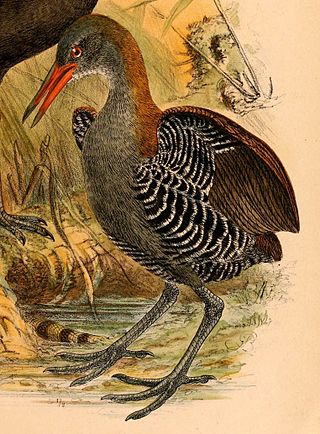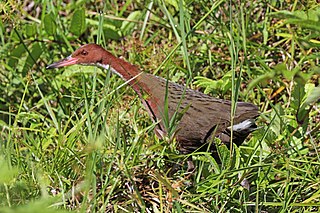
Rails are a large, cosmopolitan family of small- to medium-sized terrestrial and/or semi-amphibious birds. The family exhibits considerable diversity in its forms, and includes such ubiquitous species as the crakes, coots, and gallinule; other rail species are extremely rare or endangered. Many are associated with wetland habitats, some being semi-aquatic like waterfowl, but many more are wading birds or shorebirds. The ideal rail habitats are marsh areas, including rice paddies, and flooded fields or open forest. They are especially fond of dense vegetation for nesting. The rail family is found in every terrestrial habitat with the exception of dry desert, polar or freezing regions, and alpine areas. Members of Rallidae occur on every continent except Antarctica. Numerous unique island species are known.

The Inaccessible Island rail is a small bird of the rail family, Rallidae. Endemic to Inaccessible Island in the Tristan Archipelago in the isolated south Atlantic, it is the smallest extant flightless bird in the world. The species was described by physician Percy Lowe in 1923 but had first come to the attention of scientists 50 years earlier. The Inaccessible Island rail's affinities and origin were a long-standing mystery; in 2018 its closest relative was identified as the South American dot-winged crake, and it was proposed that both species should be nested within the genus Laterallus.

The watercock is a waterbird in the rail and crake family, Rallidae that is widely distributed across Southeast Asia. It is the only member of the genus Gallicrex.
The Calayan rail is a flightless bird of the rail, moorhen, and coot family (Rallidae) that inhabits Calayan Island in the Philippines. It is the only member of the genus Aptenorallus. Though well known to natives of the island as the "piding", it was first observed by ornithologist Carmela Española in May 2004 and the discovery was officially announced on August 16, 2004. The formal description as a species new to science appeared in the journal Forktail.

Porzana is a genus of birds in the crake and rail family, Rallidae. Its scientific name is derived from Venetian terms for small rails. The spotted crake is the type species.

The invisible rail, Wallace's rail, or drummer rail is a large flightless rail that is endemic to the island of Halmahera in Northern Maluku, Indonesia, where it inhabits impenetrable sago swamps adjacent to forests. Its plumage is predominantly dark slate-grey, and the bare skin around its eyes, the long, thick bill, and the legs are all bright red. Its call is a low drumming sound which is accompanied by wing-beating. The difficulty of seeing this shy bird in its dense habitat means that information on its behaviour is limited.

The snoring rail, also known as the Celebes rail or Platen's rail, is a large flightless rail and the only member of the genus Aramidopsis. The species is endemic to Indonesia, and it is found exclusively in dense vegetation in wet areas of Sulawesi and nearby Buton. The rail has grey underparts, a white chin, brown wings and a rufous patch on the hind-neck. The sexes are similar, but the female has a brighter neck patch and a differently coloured bill and iris. The typical call is the snoring: ee-orrrr sound that gives the bird its English name.

The black crake is a waterbird in the rail and crake family, Rallidae. It breeds in most of sub-Saharan Africa except in very arid areas. It undertakes some seasonal movements in those parts of its range which are subject to drought. No subspecies have been described. It appears that the oldest available name for this species is actually Rallus niger J. F. Gmelin, 1788, but Swainson believed that the earlier name was unidentifiable, and his own has since become well embedded in the literature.

Amaurornis is a genus of birds in the rail family Rallidae. The species in this genus are typically called bush-hens. A monotypic subtribe, Amaurornithina, was proposed for this genus.

The pale-vented bush-hen is a medium sized waterbird, mainly blue-grey with a buff vent and undertail. It is found in Australia, the Moluccan Islands, New Guinea, the Bismarck Archipelago and the Solomon Islands. Its natural habitat is subtropical or tropical moist lowland forests.

The Chatham rail is an extinct flightless species of bird in the family Rallidae. It was endemic to Chatham, Mangere and Pitt Islands, in the Chatham archipelago of New Zealand. The Chatham rail was first discovered on Mangere in 1871, and 26 specimens collected there are known from museum collections. Its Māori name was "mātirakahu".

The white-throated rail or Cuvier's rail, is a species of bird in the family Rallidae.

The pink-legged rail, also known as the New Britain rail, is a species of bird in the family Rallidae.

The Okinawa rail is a species of bird in the rail family, Rallidae. It is endemic to Okinawa Island in Japan where it is known as the Yanbaru kuina. Its existence was only confirmed in 1978 and it was formally described in 1981 although unidentified rails had been recorded on the island since at least 1973 and local stories of a bird known as the agachi kumira may refer to this species.
The Roviana rail is a species of bird in the family Rallidae. It is endemic to the Western Province.

The bare-eyed rail is a species of bird in the family Rallidae. It is found in Indonesia and Papua New Guinea. Its natural habitats are subtropical or tropical moist lowland forests and subtropical or tropical moist montane forests.

The blue-faced rail or bald-faced rail, is a species of bird in the family Rallidae. It is endemic to Sulawesi, Indonesia.

The Nkulengu rail is a species of bird in the family Rallidae. It belongs to the monotypic genus Himantornis.

Woodford's rail is a species of bird in the family Rallidae.

The white-browed crake is a species of bird in the family Rallidae. It is found in Australia, Brunei, Cambodia, Fiji, Hong Kong, Indonesia, Japan, India, Malaysia, Micronesia, New Caledonia, Palau, Papua New Guinea, the Philippines, Samoa, Singapore, Solomon Islands, Thailand, and Vanuatu.



















